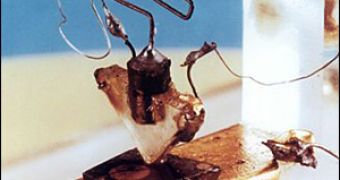Sixty years ago, at the Bell Laboratories, two scientists started a series of experiments which would result in the invention of the first working semiconductor transistor. The research was mainly triggered by the necessity of the replacement of the bulky vacuum electron tubes, which were used at the time, as elements to switch or amplify electrical signals. The vacuum electron tubes were critical for the invention of the radar, television and radio, but due to their size and characteristics, they needed to be replaced by smaller and more efficient devices.
In 1928 a German inventor, Julius Edgar Lilienfeld received three patents for the field-effect principle, but the articles about his inventions were mainly ignored by the electronics industry. Six years later another German physicist, Dr Oskar Heil received a patent for the field-effect transistor, though the device was never actually built.
On 16th of December 1947, William Shockley, John Bardeen and Walter Brattain successfully built the first point-contact transistor at the Bell Labs and demonstrated the basic mechanism that is now used in most of the electronic devices produced today.
The basic transistor is composed of two semiconductor junctions, formed by three semiconductor regions, pnp or npn. Each semiconductor region has connected to it a single terminal, meaning the transistor has three terminals: emitter, base, collector. The electric current is regulated between the emitter and the collector, by the amount of current of voltage applied on the base or gate, pretty much the same way water is regulated by a ball valve with the help of a handle.
The device worked exactly like the vacuum tubes, it amplified and switched current, but it had two major advantages. The amplification it provided was way bigger than that obtained with the electronic tubes and it was several times smaller.
The first electronic computer was created by the British in 1943 and it was named the Colossus and was used to break the code used by Germany's high command to send encoded messages. The computer building industry culminated in 1946 with the building of the ENIAC computer at the University of Pennsylvania, which was the first programmable digital computer. But both used vacuum tubes to switch and amplify electric signals, which mean they needed a lot of electric power to run them and had limited functionality.
The first produced transistor was made using germanium semiconductor with two gold contacts held in place by plastic and presents little resemblance to the transistors made today. However the inventors at Bell Laboratories filled a patent later the next year, on July 1948.
During the following years, scientists modified the basic design of the transistor into the one recognized today, which allowed it to become even smaller, to be integrated into smaller circuits, which later evolved into extremely complex circuitry to create microprocessors.
The original transistor was about half an inch in size, but now the technology has evolved and it creates transistors as small as a few nanometers. The team that invented the transistor got the Nobel Prize for Physics in 1956.

 14 DAY TRIAL //
14 DAY TRIAL //